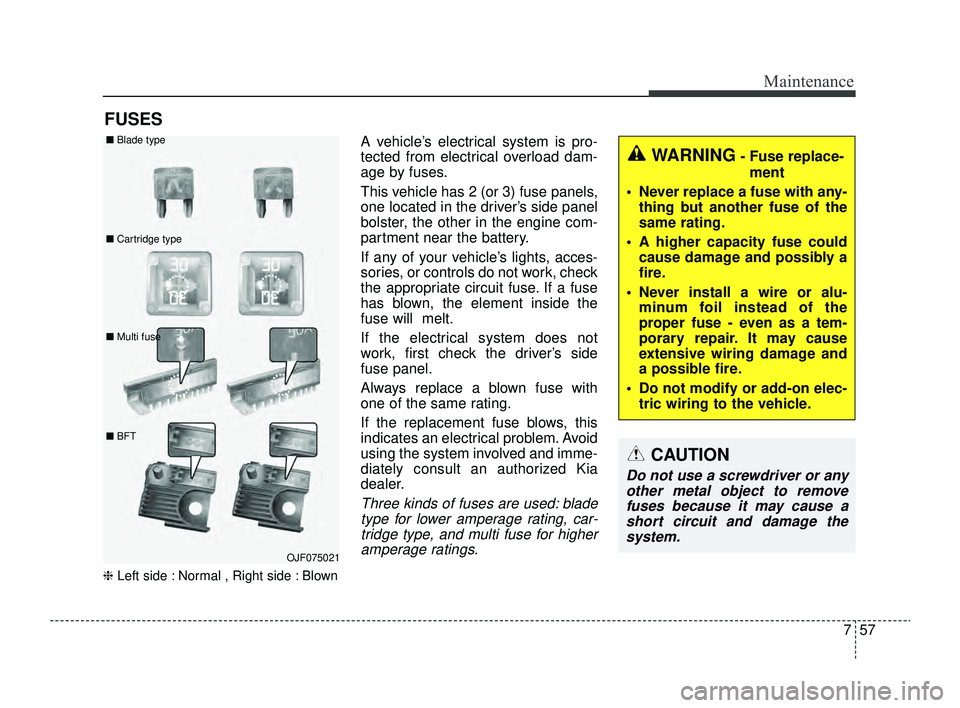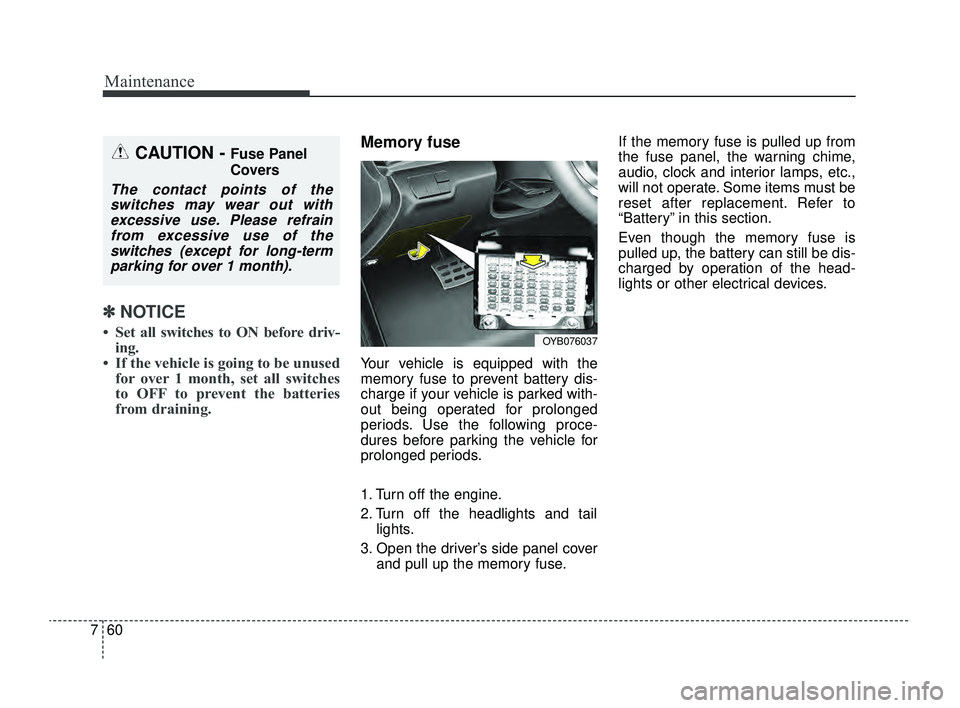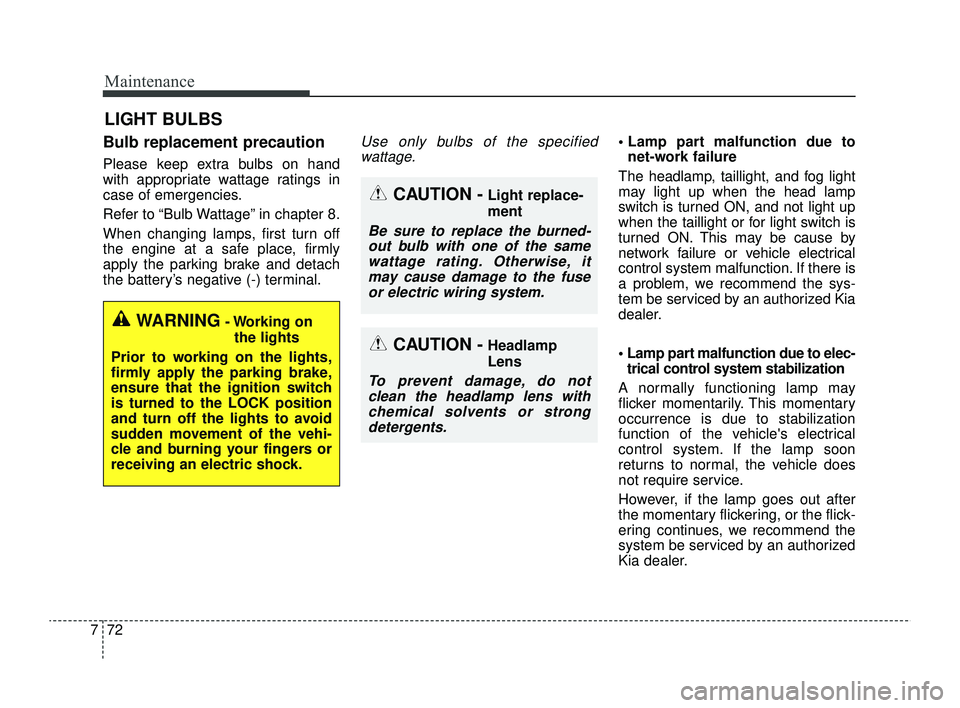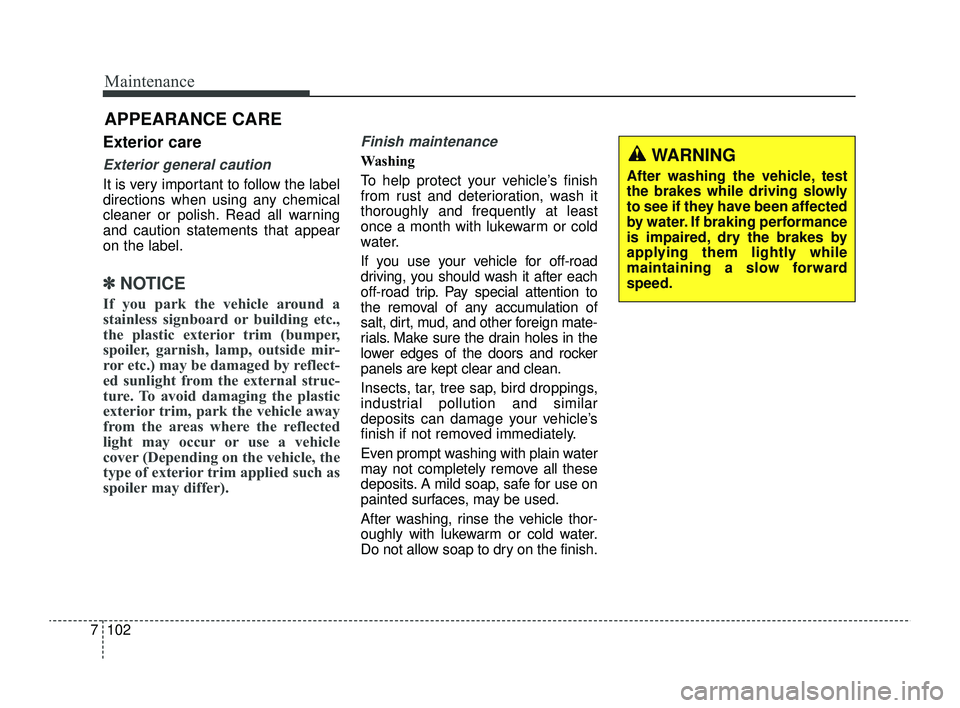2022 KIA RIO warning light
[x] Cancel search: warning lightPage 395 of 528

Maintenance
87
Check the parking brake.
Check for fluid leaks under yourvehicle (water dripping from the air
conditioning system during or after
use is normal).
At least monthly:
Check the coolant level in theengine coolant reservoir.
Check the operation of all exterior lights, including the stoplights, turn
signals and hazard warning flash-
ers.
Check the inflation pressures of all tires including the spare for tires
that are worn, show uneven wear,
or are damaged.
Check for loose wheel lug nuts.
At least twice a year (i.e., every Spring and Fall) :
Check the radiator, heater and air conditioning hoses for leaks or
damage.
Check the windshield washer spray and wiper operation. Clean
the wiper blades with a clean cloth
dampened with washer fluid.
Check the headlight alignment.
Check the muffler, exhaust pipes, shields and clamps.
Check the lap/shoulder belts for wear and function.
At least once a year :
Clean the body and door drainholes.
Lubricate the door hinges and check the hood hinges.
Lubricate the door and hood locks and latches.
Lubricate the door rubber weather- strips.
Check the air conditioning system.
Inspect and lubricate intelligent variable transmission linkage and
controls.
Clean the battery and terminals.
Check the brake fluid level.
SC PE USA 7.qxp 9/9/2021 6:26 PM Page 8
Page 444 of 528

757
Maintenance
FUSES
❈Left side : Normal , Right side : Blown
A vehicle’s electrical system is pro-
tected from electrical overload dam-
age by fuses.
This vehicle has 2 (or 3) fuse panels,
one located in the driver’s side panel
bolster, the other in the engine com-
partment near the battery.
If any of your vehicle’s lights, acces-
sories, or controls do not work, check
the appropriate circuit fuse. If a fuse
has blown, the element inside the
fuse will melt.
If the electrical system does not
work, first check the driver’s side
fuse panel.
Always replace a blown fuse with
one of the same rating.
If the replacement fuse blows, this
indicates an electrical problem. Avoid
using the system involved and imme-
diately consult an authorized Kia
dealer.
Three kinds of fuses are used: blade
type for lower amperage rating, car-tridge type, and multi fuse for higheramperage ratings.
WARNING- Fuse replace-
ment
Never replace a fuse with any- thing but another fuse of the
same rating.
A higher capacity fuse could cause damage and possibly a
fire.
Never install a wire or alu- minum foil instead of the
proper fuse - even as a tem-
porary repair. It may cause
extensive wiring damage and
a possible fire.
Do not modify or add-on elec- tric wiring to the vehicle.
CAUTION
Do not use a screwdriver or anyother metal object to removefuses because it may cause ashort circuit and damage thesystem.
OJF075021
■
Blade type
■ Cartridge type
■ Multi fuse
■ BFT
SC PE USA 7.qxp 9/9/2021 6:27 PM Page 57
Page 445 of 528

Maintenance
58
7
✽ ✽
NOTICE
• When replacing fuse, turn the
ignition “OFF” and turn off
switches of all electrical devices
then remove battery (-) terminal.
• The actual fuse/relay panel label may differ from equipped items.
WARNING- Electrical Fire
Always ensure replacements
fuses and relays are securely
fastened when installed. Failure
to do so can result in a vehicle
fire.
CAUTION
When replacing a blown fuse or relay, make sure the newfuse or relay fits tightly intothe clips. Failure to tightlyinstall the fuse or relay maycause damage to the wiringand electric systems.
Do not remove fuses, relays and terminals fastened withbolts or nuts. The fuses, relaysand terminals may not be fas-tened correctly which maycause vehicle damage.
CAUTION
Do not input any other objects except fuses or relays intofuse/relay terminals such as ascrewdriver or wiring. It maycause contact failure and sys-tem malfunction.
Do not plug in screwdrivers or aftermarket wiring into the ter-minal originally designed forfuse and relays only. The elec-trical system and wiring of thevehicle interior may be dam-aged or burned due to contactfailure.
If you directly connect the wire on the taillight or replacethe bulb which is over the reg-ulated capacity to install trail-ers etc., the inner junctionblock can get burned.
SC PE USA 7.qxp 9/9/2021 6:27 PM Page 58
Page 447 of 528

Maintenance
60
7
✽ ✽
NOTICE
• Set all switches to ON before driv-
ing.
• If the vehicle is going to be unused for over 1 month, set all switches
to OFF to prevent the batteries
from draining.
Memory fuse
Your vehicle is equipped with the
memory fuse to prevent battery dis-
charge if your vehicle is parked with-
out being operated for prolonged
periods. Use the following proce-
dures before parking the vehicle for
prolonged periods.
1. Turn off the engine.
2. Turn off the headlights and tail
lights.
3. Open the driver’s side panel cover and pull up the memory fuse. If the memory fuse is pulled up from
the fuse panel, the warning chime,
audio, clock and interior lamps, etc.,
will not operate. Some items must be
reset after replacement. Refer to
“Battery” in this section.
Even though the memory fuse is
pulled up, the battery can still be dis-
charged by operation of the head-
lights or other electrical devices.
CAUTION - Fuse Panel
Covers
The contact points of the
switches may wear out withexcessive use. Please refrainfrom excessive use of theswitches (except for long-termparking for over 1 month).
OYB076037
SC PE USA 7.qxp 9/9/2021 6:28 PM Page 60
Page 459 of 528

Maintenance
72
7
LIGHT BULBS
Bulb replacement precaution
Please keep extra bulbs on hand
with appropriate wattage ratings in
case of emergencies.
Refer to “Bulb Wattage” in chapter 8.
When changing lamps, first turn off
the engine at a safe place, firmly
apply the parking brake and detach
the battery’s negative (-) terminal.
Use only bulbs of the specified
wattage. Lamp part malfunction due to net-work failure
The headlamp, taillight, and fog light
may light up when the head lamp
switch is turned ON, and not light up
when the taillight or for light switch is
turned ON. This may be cause by
network failure or vehicle electrical
control system malfunction. If there is
a problem, we recommend the sys-
tem be serviced by an authorized Kia
dealer.
Lamp part malfunction due to elec- trical control system stabilization
A normally functioning lamp may
flicker momentarily. This momentary
occurrence is due to stabilization
function of the vehicle's electrical
control system. If the lamp soon
returns to normal, the vehicle does
not require service.
However, if the lamp goes out after
the momentary flickering, or the flick-
ering continues, we recommend the
system be serviced by an authorized
Kia dealer.
WARNING- Working on the lights
Prior to working on the lights,
firmly apply the parking brake,
ensure that the ignition switch
is turned to the LOCK position
and turn off the lights to avoid
sudden movement of the vehi-
cle and burning your fingers or
receiving an electric shock.
CAUTION -Light replace-
ment
Be sure to replace the burned- out bulb with one of the samewattage rating. Otherwise, itmay cause damage to the fuseor electric wiring system.
CAUTION -Headlamp
Lens
To prevent damage, do notclean the headlamp lens withchemical solvents or strongdetergents.
SC PE USA 7.qxp 9/9/2021 6:28 PM Page 72
Page 489 of 528

Maintenance
102
7
APPEARANCE CARE
Exterior care
Exterior general caution
It is very important to follow the label
directions when using any chemical
cleaner or polish. Read all warning
and caution statements that appear
on the label.
✽ ✽
NOTICE
If you park the vehicle around a
stainless signboard or building etc.,
the plastic exterior trim (bumper,
spoiler, garnish, lamp, outside mir-
ror etc.) may be damaged by reflect-
ed sunlight from the external struc-
ture. To avoid damaging the plastic
exterior trim, park the vehicle away
from the areas where the reflected
light may occur or use a vehicle
cover (Depending on the vehicle, the
type of exterior trim applied such as
spoiler may differ).
Finish maintenance
Washing
To help protect your vehicle’s finish
from rust and deterioration, wash it
thoroughly and frequently at least
once a month with lukewarm or cold
water.
If you use your vehicle for off-road
driving, you should wash it after each
off-road trip. Pay special attention to
the removal of any accumulation of
salt, dirt, mud, and other foreign mate-
rials. Make sure the drain holes in the
lower edges of the doors and rocker
panels are kept clear and clean.
Insects, tar, tree sap, bird droppings,
industrial pollution and similar
deposits can damage your vehicle’s
finish if not removed immediately.
Even prompt washing with plain water
may not completely remove all these
deposits. A mild soap, safe for use on
painted surfaces, may be used.
After washing, rinse the vehicle thor-
oughly with lukewarm or cold water.
Do not allow soap to dry on the finish.WARNING
After washing the vehicle, test
the brakes while driving slowly
to see if they have been affected
by water. If braking performance
is impaired, dry the brakes by
applying them lightly while
maintaining a slow forward
speed.
SC PE USA 7.qxp 9/9/2021 6:31 PM Page 102
Page 518 of 528

Index
2I
Air bag - advanced supplemental restraint system ........3-34Adding equipment to or modifying your air bag-equipped vehicle ......................................................3-62
Air bag warning label ................................................3-62
Air bag warning light ..................................................3-38
Curtain air bag ............................................................3-54
Driver's and passenger's front air bag ........................3-49
How does the air bag system operate ........................3-35
Inflation and non-inflation conditions of the air bag..3-56
Occupant detection system ........................................3-41
Side air bag ................................................................3-52
SRS Care ....................................................................3-61\
SRS components and functions ..................................3-38
Air cleaner ....................................................................7-31\
Filter replacement ......................................................7-31
Air conditioning system ..................................................8-6
Appearance care ..........................................................7-102 Exterior care ..............................................................7-102
Interior care ..............................................................7-108
Automatic climate control system ..............................4-122 Activate upon washer fluid use ..............................4-134
Air Conditioning refrigerant label ............................4-133
Automatic heating and air conditioning ..................4-123
Checking the amount of air conditioner refrigerant and compressor lubricant ..............................................4-132
Climate control air filter ..........................................4-131 Manual heating and air conditioning ........................4-124
System operation ......................................................4-129
Battery........................................................................\
....7-39 For best battery service ..............................................7-39
Recharging the battery ................................................7-40
Reset items ..................................................................7-41
Before driving ..................................................................5-5 Before entering vehicle ................................................5-5
Before starting ............................................................5-5
Necessary inspections ................................................5-5
Blind-Spot Collision Warning (BCW) ..........................5-65 Blind-Spot Collision Warning malfunction andlimitations ................................................................5-70
Blind-Spot Collision Warning operation ....................5-69
Blind-Spot Collision Warning settings ......................5-67
Detecting sensor ..........................................................5-66
Brake fluid ....................................................................7-27\
Checking the brake fluid level ....................................7-27
Brake system..................................................................5-25 Anti-lock Brake System (ABS) ..................................5-30
Electronic Stability Control (ESC) ............................5-31
Good braking practices ..............................................5-38
Hill-start Assist Control (HAC) ..................................5-35
Parking brake ..............................................................5-27
Power brakes ............................................................5-25
A
B
SC PE USA Index.qxp 8/23/2021 5:25 PM Page 2
Page 520 of 528

Index
4I
Emission control system ..............................................7-111Crankcase emission control system ..........................7-111
Evaporative emission control (including ORVR: Onboard Refueling Vapor Recovery) system ........7-111
Exhaust emission control system ..............................7-112
Engine .................................................................\
...........8-2
Engine compartment ................................................2-7, 7-4
Engine coolant ..............................................................7-24 Changing the coolant ..................................................7-26
Checking the coolant level..........................................7-24\
Engine number ..............................................................8-10
Engine oil ......................................................................7-\
21 Changing the engine oil and filter ..............................7-22
Checking the engine oil level ....................................7-21
ENGINE START/STOP button ....................................5-10 ENGINE START/STOP button position ....................5-10
Illuminated ENGINE START/STOP button ..............5-10
Starting the engine ......................................................5-13
Explanation of scheduled maintenance items ..............7-15
Exterior overview ............................................................2-2
Forward Collision-Avoidance Assist (FCA)..................5-41 Brake operation ..........................................................5-46
Detecting sensor ..........................................................5-41
Forward Collision-Avoidance Assist malfunction ......5-48
Forward Collision-Avoidance Assist settings ............5-42 Forward Collision-Avoidance Assist warning message
and function control ..................................................5-44
Limitations of Forward Collision-Avoidance Assist ..5-50
Warning message and warning light ..........................5-47
Fuel filler door ..............................................................4-42 Closing the fuel filler door..........................................4-\
43
Opening the fuel filler door ........................................4-42
Fuel requirements ............................................................1-3 Do not use methanol ....................................................1-4
Gasoline containing alcohol and methanol ..................1-3
Fuses ........................................................................\
......7-57 Engine compartment fuse replacement ......................7-61
Fuse/relay panel description ......................................7-63
Inner panel fuse replacement ......................................7-59
Memory fuse ..............................................................7-60
Hood ........................................................................\
......4-39 Closing the hood ........................................................4-40
Hood open warning ....................................................4-40
Opening the hood ......................................................4-39
How to use this manual ..................................................1-2
F
H
SC PE USA Index.qxp 8/23/2021 5:25 PM Page 4